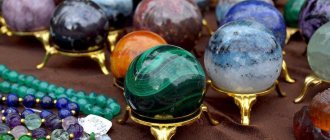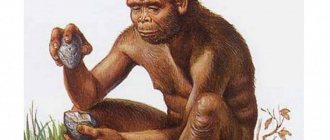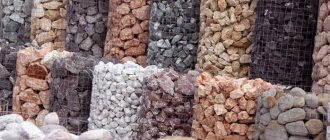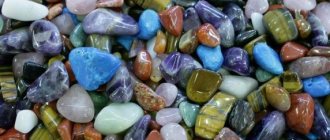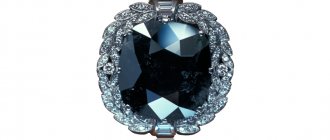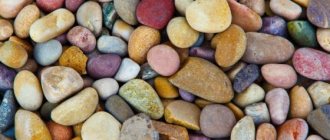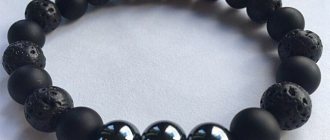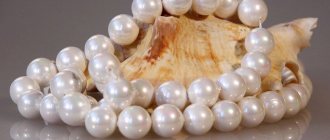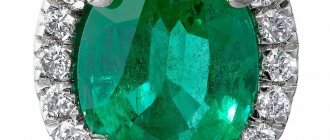The world of precious stones and gems is vast and fascinating. Bright and fascinating crystals have been used since ancient times to make jewelry and used as banking assets. Each mineral has an individual history, color and properties. Nowadays, the science of gemology deals with the study of precious stones. Modern methods of classifying minerals differ from old methods and allow us to better understand the whole variety of precious and ornamental stones.
What is a gem
Gems are a historical and everyday term used to designate precious, semi-precious and ornamental stones used in jewelry and decorative and applied arts or as ornamental raw materials. According to the classification of Academician A. E. Fersman, only transparent stones can be considered gems, regardless of which group they belong to, and opaque specimens are usually classified as colored stones. However, now the term “gems” can be used in relation to any mineral, be it an ornamental or precious stone.
Properties of gems
The following features are characteristic of precious stones:
- Rarity. Some varieties of gems are expensive due to their uniqueness, as they are difficult to find and obtain. The depletion of mineral deposits also affects the demand and cost of individual species.
- Hardness. The durability of gemstones directly depends on their strength, which is influenced by hardness, cleavage and other physical properties.
- Appearance - this takes into account not only the initial appearance of the mineral after mining, but also how the gem will look after processing. Jewelers evaluate clarity, color, pattern, light refraction, shine and polishability.
- Origin. Scientists have learned to create imitations of stones by growing crystals in laboratories or by coloring less valuable natural specimens to pass them off as another stone. Despite the fact that fakes sometimes look more beautiful and more durable than natural minerals, the latter are still valued higher.
- Compactness. Small gemstones have been used since ancient times to this day as a measure of value. Most expensive minerals are small in size. The discovery of large crystals is considered extremely rare.
Distinctive features of expensive gems
The most expensive gems have one thing in common: incredible strength and hardness, thanks to which they do not wear out and last for centuries. The hardness of gems can be assessed on the Mohs scale (in units).
The hardest gem is diamond. This is the only natural stone with a hardness of 10 units. Following it with 9 units are sapphires and rubies. Hardness 8 units. has emerald, noble topaz, as well as alexandrite, chrysoberyl. Aquamarine, spinel, and cat's eye have the same characteristics.
Rose quartz, amethysts and hyacinth, as well as garnet, citrine, tourmaline, and smoky topaz all have a hardness of 7 on the Mohs scale.
In addition to hardness, minerals are valued for their size: the larger, the more expensive the gem. Weight is usually measured in carats (1 carat = 200 mg). What matters is the color, transparency, presence of inclusions, cracks, and the ability to cut the stone. There are 250 options for cutting minerals.
Expensive specimens are capable of transmitting light, creating its play, shimmering, refracting rays or absorbing them. Another distinctive feature is the rarity of the deposits.
Description of gems
Gems are divided into translucent and transparent. The weight of different stones varies from several grams to hundreds of kilograms. For example, the largest ruby weighs 459 g, and topaz crystals can reach a couple of hundred kg.
The color of the stones also varies: expensive diamonds are colorless, like a teardrop, while emerald has a rich shade of fresh greenery. The uniqueness of color, properties, weight and origin makes each precious and semi-precious stone one of a kind, which jewelers successfully use when making unique jewelry.
Classification of stones
Gems differ from each other in various ways, so people have a need to classify them. There is no single division: jewelers classify crystals according to one characteristic, gemologists - according to another, and sellers are only interested in the cost of the specimens.
The first attempts to classify minerals belonged to Professor K. Gurich. Some time later, in 1986, Bauer brought greater clarity to the description of stones, dividing gems into three types:
- precious;
- ornamental;
- organic stones.
But many other rocks were not included in this characteristic, so currently most experts use the classification according to V. Ya. Kievlenko, who ordered the stones as follows:
- Jewelry - the group includes expensive and rare minerals, which are divided into 4 orders.
- Jewelry and ornamental gems - like the first category, are divided into orders.
- Ornamental stones - used for making jewelry and interior items.
For clarity, you should familiarize yourself with the table, which contains a list of the names of minerals included in one or another category.
In addition to this classification, gems are usually divided according to geography. Different types of stones are mined all over the world, but the most famous are the gems from Siberia and hot countries.
For example, at the foot of Mount Kilimanjaro there are deposits of rare and expensive tanzanite. Asia is known for its deposits of large sapphires and rubies, and Japan produces record quantities of cultured pearls. In Russia there are the famous Ural deposits, where malachite, amethyst, topazes and even emeralds are mined. It is interesting that in the old days blue Ural topazes in Europe were given the name “Siberian diamonds”. It is worth mentioning Yakutia - expensive diamonds with a high degree of purity are mined here.
There is a division of minerals depending on the nature of their formation. Classification of natural stones by origin:
- Igneous. As erupted magma cools, various minerals form within the earth. Gems begin to grow in the cavities of rocks, creating rubies, sapphires or topazes, and the difference between the stones is due to the chemical composition or viscosity of the magma.
- Metamorphic - formed under the influence of physicochemical factors in the bowels of the earth, which affect the layers of the soil. Under the influence of various factors, breeds are transformed. This group includes, for example, garnet, marble and feldspar.
- Organic. The peculiarity of representatives of this group is that once upon a time the stones were something living, and then they turned to stone. A striking example is pearls, which are formed in shells as a result of the coating of foreign inclusions with mother-of-pearl, or amber, which is the petrified resin of trees.
Physical characteristics of mineral stones
Photos of various minerals that differ in their physical properties
These physical properties are characterized by:
- color;
- hardness;
- specific gravity;
- flammability;
- transparency;
- the nature of the fracture;
- electrical conductivity;
- smell;
- fragility;
- hygroscopicity;
- roughness or smoothness of the surface;
- fat content
Rare stones are valued for their color and transparency. Many physical properties are determined by the crystal lattice, chemical composition, and the presence of organics. The most difficult and often incomprehensible question remains the nature of color. So far, scientists explain it by the special properties of the spectral composition of a particular mineral, allowing it to reflect light radiation, or by a specific chemical composition.
Various influences of external factors during the formation of stones lead to uneven distribution of the coloring pigment. There are gems with varying degrees of color intensity, rainbow coloring, and different colors along the entire length. Color is usually determined by visual comparison with a standard color line. Of all the other physical properties, the color attribute is considered the most unstable and uncharacteristic, since it can vary, even among minerals with the same chemical composition.
An important feature is transparency. It provides the ability to transmit light. According to this physical property, stones are divided into:
- Transparent
- Translucent
- Opaque
They can be shiny or matte. The shine is due to their physical properties that allow them to reflect light. Based on this property, lustrous gems are divided into those that have a metallic luster and those whose luster has the characteristics of a semi-metallic reflection.
An important property is cleavage. It depends on the type of crystal lattice, which determines the number of planes on their surface that appear after splitting. Usually it can reach 6. Geologists distinguish between different types of cleavage: perfect, average, imperfect, very imperfect.
Attention is drawn to the type of fracture, which can be:
- stepped;
- conchoidal;
- splintered;
- hooked.
The degree of hardness varies, which is determined by the type of crystal lattice and the strength of the bonds of atoms. This physical property is determined by scratching the stone surface. Specific gravity allows minerals to be divided into heavy, medium and light. This indicator is highest for nuggets and ore. Another physical property of gems is their magnetism.
Separation of gems by color
The name “gem” indicates that each stone has an individual color. In the old days, it was believed that the shades of minerals were not random - magical abilities and healing properties were attributed to each color. In the modern world, there is a special science - color psychology, which studies the influence of colors and shades on humans.
The choice of stone color for jewelry plays a big role.
Scarlet is a symbol of movement, so rings and earrings with ruby are suitable for active and enterprising people.
When choosing a precious item, you need to take into account the main character traits of the future owner.
Purple
The color purple symbolizes wisdom and inner intuition and helps to achieve hidden secrets. Among the gems of purple and lilac shades, the following stand out:
- Ametrine - combines two minerals: citrine and amethyst. It is considered rare because it is mined only in one place - in the mines of Bolivia. Areas of lemon and purple colors are combined unevenly or zonally.
- Amethyst is a purple variety of quartz, a rare and beautiful stone. The amethyst palette includes different shades that give the color richness and depth.
- Kunzite is a mineral discovered recently, but immediately fell in love with due to its unusual color. Color - violet with shades of pink and light red.
- Sugilite is one of the youngest precious minerals, ranging in color from purple-blue to light pink. It is mined only in a few places around the world, so it is considered expensive and rare.
- Jade. Lavender stone is the rarest representative of the jade group. It is mined in the Urals and Kazakhstan.
- Charoite is a stone with a mysterious name mined in Russia. Thanks to the manganese it contains, the color of the gem varies from light lilac to violet.
Ametrine
Kunzite
Sugilite
Charoite
Blue
Minerals and gems with blue colors are considered one of the most beautiful and expensive. The value of natural sky-colored stones is due to their rarity and the fact that the blue color represents greatness and knowledge. Sometimes jewelers specially tint inexpensive minerals to achieve a uniform blue tone, as this increases the cost of the item.
Among natural blue gems, the following stand out:
- Sapphire is the king of blue stones, because even the name of the mineral is translated as “blue.” There are sapphires in other colors, but azure ones are the most expensive.
- Lapis lazuli is a soft and brittle mineral, colored in various shades of blue and blue.
- Turquoise. The stone has been loved and known to people since ancient times. The color of turquoise varies from light sky to blue-green shades.
- Benitoite is a beautiful mineral with a deep blue color. Considered expensive due to scarce deposits.
- Indigolite is a rare variety of tourmaline that can be dark blue, black-blue or sea green.
Turquoise
Sapphire
Lapis lazuli
Indigolite
Reds
Red crystals and gems symbolize fire, passion and energy and have been highly valued at all times. Among the fiery minerals, there are both inexpensive representatives, for example, corals, and valuable ones, such as fiery rubies.
Gems of scarlet tones:
- Ruby is a type of corundum, one of the most valuable stones in the world along with diamonds and sapphires. The color palette includes rich dark red tones and light scarlet shades.
- Hyacinth is a precious red-brown gemstone with a diamond shine.
- Almandine is a variety of red and scarlet-violet garnets. The color of almandines can be purple or cherry red.
- Carnelian is a red-pink or scarlet-yellow variety of chalcedony.
Almandine
Hyacinth
Carnelian
Ruby
Greens
Green is the color of life and health, so natural minerals in emerald shades were given great importance. It is believed that stones in a shade of fresh greenery calm the nerves, prolong life and bring harmony. In addition to these qualities, jewelers and buyers value “herbal” gems for their rich color.
The group of green minerals includes:
- Emerald is a rare precious crystal. The color ranges from light green to dark green. It is worth noting that emeralds without defects are more valuable than diamonds.
- Jade is a mineral colored in light shades of green, used as an ornamental material and for making decorative items.
- Malachite is a gem of a deep dark green tone. The largest deposits of malachite are located in Russia.
Malachite
Emerald
Nephritis
Yellow
Gold, lemon, orange are shades of happiness, good luck and material well-being. Jewelry inlaid with golden stones can bring luck to the owner’s life, which is why yellow gems are among the best-selling:
- Amber is a stone with an amazing origin. This is the resin of coniferous trees, frozen millions of years ago. In nature, there are specimens of yellow and dark-golden flowers, as well as greenish and silver ones.
- Citrine is a variety of quartz that is recognized for its ease of processing. The color of the gem includes all shades of yellow.
- Heliodor is a type of beryl. It lends itself well to cutting and has a wide palette of sunny tones.
- Topaz is a golden-yellow mineral that is highly reliable and durable.
Heliodor
Topaz
Citrine
Amber
Products made from gems
Precious and semi-precious stones have long been valued by people due to their bewitching beauty and dazzling brilliance. Minerals were used for healing and magical rites . It was believed that wearing minerals could cure terrible diseases or poisonous snake bites.
Durable and sparkling gems not only “treated”, but also helped ancient people develop. Weapons, knives and axes were made from stones, then used to make things. However, the most valuable were the minerals used in jewelry. Various decorations were created from them:
- bracelets, brooches and rings;
- necklaces, beads, pendants;
- tiaras, crowns, crowns and earrings.
Thanks to the skill and labor of jewelers, there are products that have no equal in beauty.
For jewelry intended for the nobility, only expensive stones were used - diamonds, sapphires, emeralds, and other dazzling and sparkling gems.
Poorer people were content with products with jasper and agates.
Among the most famous gems, the following are especially amazing:
- The Hope Diamond is a huge bluish stone weighing 45.52 carats. Diamond is the most durable gem and is considered the king of minerals. The Hope Diamond is now set in a necklace and kept in the Smithsonian Institution.
- The Tiffany Diamond is a yellow diamond of amazing beauty weighing 128 carats. The crystal is set into a diamond necklace and displayed in Tiffany's flagship store in New York.
- Tiara made of emeralds. The decoration was created in 1900, and the tiara was owned by Princess Katharina Henckel von Donnersmarck. It was created using 11 pear-shaped Colombian emeralds, diamonds, silver and gold.
- The “Incomparable” necklace is considered the most expensive in the world. Consists of a yellow diamond weighing 407 carats and many diamonds weighing 230 carats. It is noteworthy that the crystal crowning the necklace was found by a little girl from the Republic of Congo in a pile of ordinary stones.
- Faberge eggs are a famous series of jewelry created by Carl Faberge and his assistants. The series consists of 71 items made of precious metals and inlaid with gems. Only 65 eggs have survived to this day, some of which are kept in museums.
- The Rosser Reeves Star Ruby is the largest star ruby in the world and has an asterism effect.
Faberge Egg
Diamond Hope
Necklace - “Incomparable”
The magical power of crystals
Since ancient times, gems and minerals have been valued by people not only for their external beauty, but also for their magical properties. Sorcerers and healers used stones to treat the sick, rituals and offerings, and the abilities of gems were glorified in ancient legends. Nowadays, jewelry stones are used in lithotherapy, where diseases are treated in an unconventional way.
Each of the natural gems has individual strength and properties:
- Agate is a mineral that will give you long life and health, and will help you recognize the enemy in your neighbor.
- Amethyst is the gem of people in love. Wearing a product with amethyst will help relieve internal pain and relieve stress, and will protect you from drunkenness.
- Lapis lazuli is a stone that will relieve insomnia, eliminate skin ailments and improve blood circulation.
- Jade - in ancient times, the mineral was considered a “kidney” gem. People thought that wearing jade jewelry would cure kidney disease.
- Garnet is a gem that relieves arthritis and joint pain.
- Ruby is a stone that can give its owner power, strength and determination of spirit and will lead to the goal.
- Tourmaline and carnelian are love minerals that will help you find love.
- Emerald is a money talisman. Wearing an emerald helps build relationships with beneficial people.
- Aventurine is a gem that can restore vital energy and good spirits.
- Sapphire is a precious stone that develops thinking and abilities, awakens a thirst for knowledge.
- Topaz is a mineral that protects against depression, helps calm nerves and calm emotions.
- Aquamarine is a symbol of tranquility and the sea, protecting travelers from misfortunes on the road.
- Diamond - a mineral changes the character of the owner, awakening the best qualities: determination, self-control.
- Alexandrite is a stone useful in the fight against aggression and anger.
- Opal is a precious gem that helps you gain confidence in your own abilities and restore your emotional state. Able to warn the owner about diseases by changing color.
- Citrine is a precious stone that will bring success in business and work, give energy and relieve laziness.
- Amber is a mineral that will restore cheerfulness and eliminate negative thoughts.
Agate
Aquamarine
Matching stones according to zodiac signs
Astrological advice has long been ingrained in the idea of jewelry stones:
- Aries – garnet, diamond, amethyst, ruby, tourmaline;
- Taurus – emerald, peridot, turquoise, agate;
- Gemini – pearls, topaz, beryl;
- Cancer – amethyst, onyx, pink sapphire;
- Leo - amber, sapphire, cat's eye;
- Virgo – jade, emerald, jasper, carnelian;
- Libra – topaz, opal, lapis lazuli, aquamarine;
- Scorpio – ruby, coral, opal, emerald;
- Sagittarius - garnet, tiger's eye, citrine;
- Capricorn – ruby, malachite, onyx;
- Aquarius – zircon, aquamarine, amethyst;
- Pisces – moonstone, pearls, agate, amethyst.
Even if you don't believe in horoscopes, you should listen to your inner voice when choosing jewelry. After all, you'll likely be wearing it for many years. Therefore, be sure to evaluate not only the quality or aesthetic aspects, but also your feelings.
Legends about gemstones
Precious gems, mined since ancient times, have their own history of birth. Many of the minerals are mentioned in ancient legends and tales that have survived to this day.
The myth of amethyst
The history of the appearance of amethyst is closely connected with the god of wine and fun, Dionysus. According to legends, when Dionysus got drunk, he became angry and aggressive. At the time of the next feast, God became so angry that he ordered to kill people on his way and, by the will of fate, met the nymph Amethyst. Having prayed to the gods, Amethyst asked to protect her from the lions of Dionysus, and the gods had mercy, turning the nymph into a frozen stone.
Waking up the next day, Dionysus did not believe that it was his fault that the nymph turned into a statue. The God of Fun tried to revive Amethyst with wine, but the attempts were useless - the stone only turned purple. This is how the precious amethyst crystal appeared.
The Tale of Onyx
Onyx is an ornamental striped gem, the legend of which is associated with the Greek goddess of love Aphrodite. According to legends, when Aphrodite fell asleep, Eros, playing with a bow, accidentally released an arrow and hit his mother’s hand. Aphrodite's fingernail fell to the ground and turned into a striped mineral. In support of this, the name of the gem is translated from Greek as “nail”.
Ruby - dragon stone
There are many legends and stories about the ruby, but the most interesting of them is related to dragons. According to ancient legends, rubies appeared from the eggs of the dragon Naga and ripened in the depths of the earth, filling with scarlet color. Some of the priests believed that the scarlet minerals were the tears of dragons, which flowed from the eyes of mythical creatures when the dragons died. Interestingly, the philosopher Plutarch adhered to this same version.
Gorge of Diamonds
Diamond is the most durable gem, and has long been valued above other minerals. According to legend, a long time ago there was a gorge, the bottom of which was strewn with precious diamonds. However, the gems were guarded by poisonous snakes, and it was impossible to get to the stones. Then people came up with a way to get treasures - they dropped pieces of raw meat to the bottom of the gorge, to which diamonds stuck, and then mountain eagles carried away the stones along with the prey.
Natural gems are a creation given to humanity by nature. It was believed that each mineral has its own soul and properties, thanks to which the stone works miracles. Even if we discard claims that gems have magical powers, the beauty, strength and dazzling brilliance of minerals are undeniable. From ancient times to this day, precious gems have fascinated and attracted the human eye with their play of light and radiance.
Using stones in the home
In the house, the favorable energy of stones will improve life and comfort. Using the unique properties of stones, you can choose the most suitable furniture and appliances. A correctly selected stone will serve as a good gift for your family and friends.
Romantic and cordial relationships
By choosing a stone for yourself, you can strengthen your love and strengthen it. If you are actively searching for your soulmate, the stone will help bring the moment of the desired meeting closer. If tension has appeared in your relationship, former passions have faded a little, then the energy of the stone will strengthen and return passion and feelings.
Business, career, finance
If you choose the right stone, your business will prosper and your finances will grow. There will be additional opportunities for development and career growth. You will benefit from the conditions of the modern market. Even if something went wrong, you do not meet the delivery deadlines, or maybe somewhere did not meet expectations, the energy emitted by the stone will work in such a way that you will definitely have a second chance.
If you want to improve your well-being, improve your health, and increase your vitality, contact a professional astrologer. A specialist will help you choose the right stone.
By

